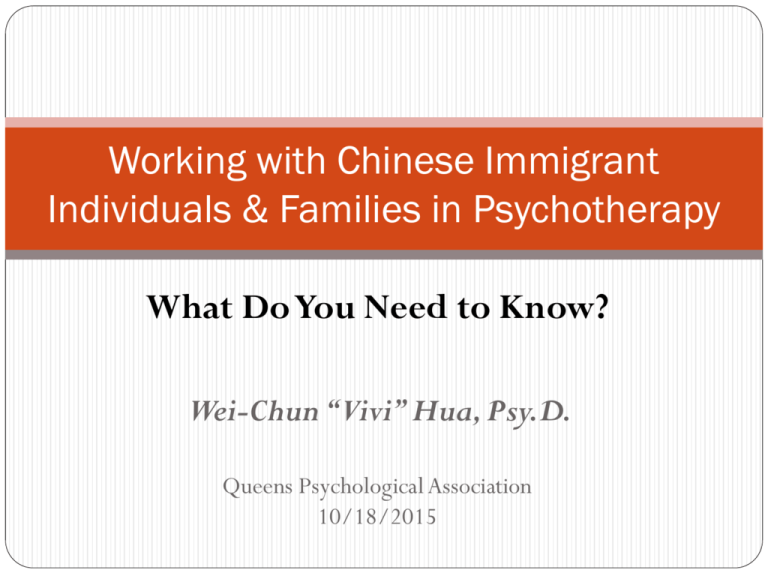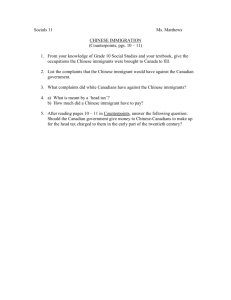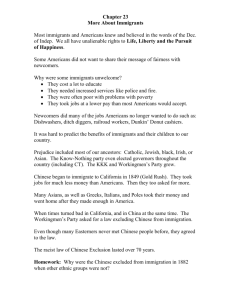Working with Chinese Immigrant Individuals and Families in
advertisement

Working with Chinese Immigrant Individuals & Families in Psychotherapy What Do You Need to Know? Wei-Chun “Vivi” Hua, Psy.D. Queens Psychological Association 10/18/2015 Outline My background: cultural and professional Background of Chinese immigrants in NYC Major presenting issues of (undocumented) Chinese immigrants Cultural differences in therapy My Cultural Background • Country of origin • Immigration • Language My Professional Background • Gouverneur Healthcare Services (NYCHHC) • Early childhood center • SCO Family of Services (foster care) Chinese Immigrants in NYC Older generations of Chinese immigrants Cantonese-speaking After 1980-1990s: Fuzhou, Fujian Province of China Fuzhounese, Mandarin-speaking A large number w/o documentation Primary population in local, social service agencies in Chinese community Major Presenting Issues A sense of loss Family & social network: source of support Use of language Identity: majority group → minority group Power Resources Sense of belonging The self is split Major Presenting Issues (cont’d) Acculturation/adjustment issues Language Food Holidays Transportation Navigating new systems School: parental rights, parent teacher conferences Legal: “appropriate” parenting Medical Common Clinical Symptoms Depression: sleep problems, loss of appetite Anxiety: heart palpitations, shortness of breath Anger, explosive behavior Psychosomatic symptoms Undocumented Chinese Immigrants Late teens and early 20s No or limited work experience Experience of stressors on multiple levels First time away from home Traumatic, circuitous migratory journey Dependent → provider of the family Huge debts to pay off Development of psychopathology Limited access to healthcare Psychiatric hospitalizations Stigma about Therapy Therapy is a foreign concept Therapy is for “crazy” people! They come to therapy because they “have to” Utilization of: Family or social network Fortune-telling Religion, spirituality: pray, karma, vegetarian diet Western Society Based Therapy Much value on info from the client Thoughts and feelings Inner conflicts Early life history/stories Cultural Differences in Therapy Expressions Verbal Feelings and emotions are not a typical part of daily language Not as consciously and verbally in tune with their feelings Catch the moment, pause, and ask: What just came to your mind? Reflect that:You look sad, angry, confused, etc Cultural Differences in Therapy (cont’d) Nonverbal Gives out more info than verbal Eye contact Head-nodding: attention, not necessarily agreement Matching of affect Pay attention to nuances in their facial, nonverbal expressions Cultural Differences in Therapy (cont’d) Pragmatic orientation Focus on the present and problem-solving: Education Job Benefits, resources, etc Daily living: transportation, family activities, etc Cultural Differences in Therapy (cont’d) Respect for hierarchy/professionals Professional status and title Dr./Ms./Mr. vs. first names Teacher – student dynamics Directive vs. exploratory Learning, psychoeducation Specific goals, homework Little questioning: frame-setting Chinese Families Children Extensions of their parents and family Their success/failure matters to the family Know his/her role and obligations within the family Parents Life purpose: to help their children succeed Self-sacrifice Chinese Immigrant Families Intergenerational conflicts Immigrant parents vs. Children born or came here when little Generational differences Traditional Chinese values vs. American values Conflicts often arise when: Decline in academic performance Change in behavior: stay out late, makeup, clothing, smoking,... Involvement in a romantic relationship as adolescents Chinese Immigrant Families A case Child:16 yo Chinese -American female Mother: immigrated to the U.S. in her late 20’s Involvement w ACS In therapy: Validate their different values Help them understand each other’s perspective Facilitate communication How to move forward? What are absolutely important for each of them? Contact Information Wei-Chun “Vivi” Hua, Psy.D. vivihua06@gmail.com







